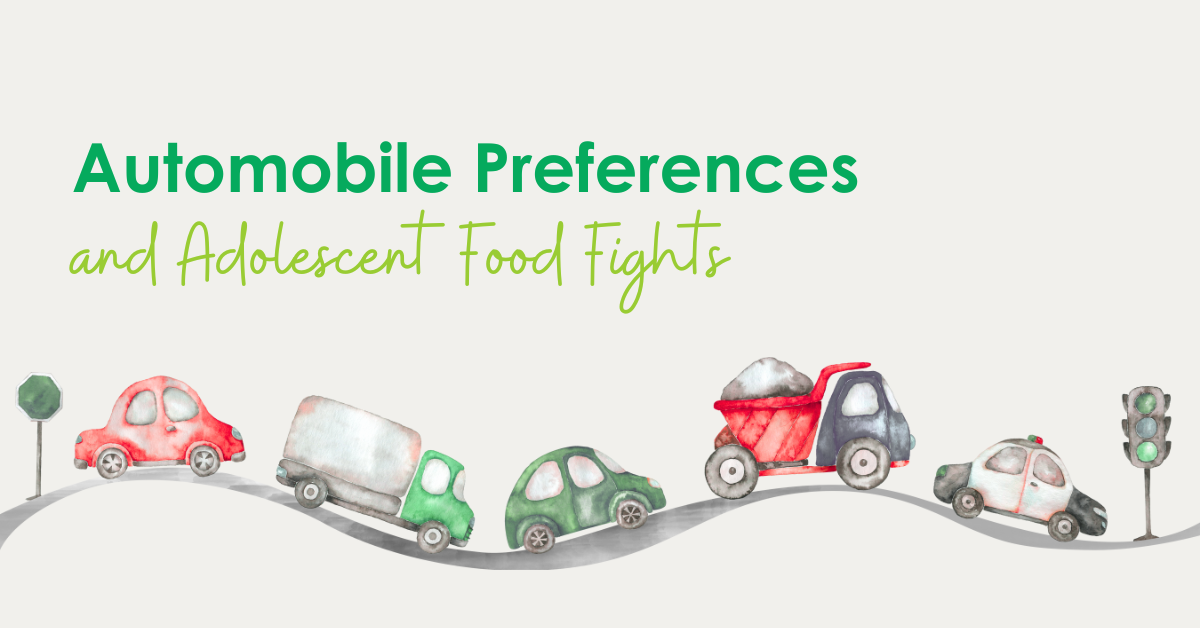
Last week, The Wall Street Journal quietly mentioned that the transition to electric vehicles died months ago. “After the highly anticipated EV boom in the U.S. fizzled out, President Trump and Congress set out to eliminate state and federal regulations they argue were designed to mandate battery-powered vehicles for American consumers.” I missed the news stories and headlines declaring the EV market dead. I don’t think it’s dead. Consistent with my 15-year-old prediction, I believe they are headed for a niche slice of the market with a steady 5-10% U.S. market share. They have their place in the market.
In case you missed it, as did I, the United States Senate voted in May to nullify California’s authority to set its own vehicle emission standards and ban internal combustion engines for automobiles. California had used a waiver feature of the Clean Air Act to address its horrendous smog pollution in the 1960s, when lead (yes, the brain-damaging element) was added to gasoline to prevent spontaneous fuel combustion known as engine knock. Lead was eventually banned for use in gasoline. Why? Catalytic converters were required to eliminate emissions that caused ground-level ozone, nitrogen oxides, and smog. Leaded gasoline would plug catalytic converters. Back in the 1980s, mechanics would take care of this problem by chopping out the catalytic converter to allow the use of leaded gasoline. Anyway, California bastardized the purpose of the waiver system to apply to carbon dioxide and to eliminate the use of internal combustion engines. The Senate said nada.
Know Your Customer Base
Detroit (General Motors, Ford, and the company formerly known as Chrysler) rejoices as they can now return to what they do best – build and sell highly profitable gas guzzlers that millions of Americans want and scuttle their pipedreams of becoming EV manufacturers. Ford will no longer need to sell five or ten guzzlers to offset the losses from one Ford Lightning or Mach-E sale. The Journal reports that the Big Three agreed to pay $10 BILLION on regulatory credits and fuel-economy rule-violation fines since 2022. Still, they are keeping a toe in the EV development laboratory for some reason. They should pay attention to their lucrative customer base rather than know-nothings in Washington. The know-nothings should stay out of the automobile industry just as they should not design the electric grid.
Perchance, if the Big Three focused on their customers and what they did well, they could make some money, and their stock prices might perform well. Indeed, you have to look hard to find their microscopic stock valuation on Figure 1. Despite Nvidia’s eyepopping valuation, the company on this chart that impresses me most is Coca-Cola, which produces and owns only non-alcoholic beverages. That’s impressive to me.
Figure 1 July 10, 2025, Stock Valuations
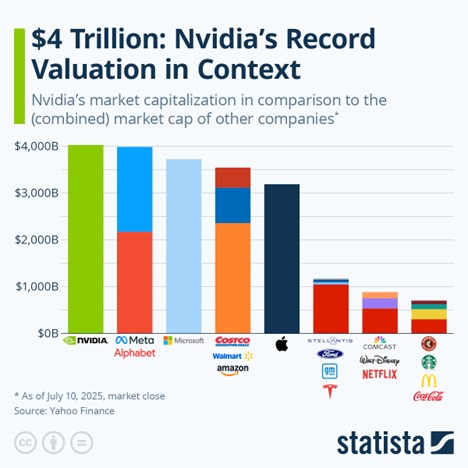 EV Deals
EV Deals
The headline of a July 6, 2025, Wall Street Journal article is “Has There Ever Been a Better Time to Buy an EV?” My answer is probably not as EVs pile up on dealer lots, the tax credits are set to expire (get ’em while they’re hot), and dealers are slashing prices to unload them. Yet, EV sales dropped for the third straight month in June by over 6% and Tesla sales plummeted even further, 13.5% in the second quarter, as Musk Derangement sets in like polio to the EV industry. In the quarter, Tesla offered Model 3s at $42,000 with 0% financing. Cybertrucks started at $69,990!
Meanwhile, Ford, BMW, Hi Un Die, and others are offering free home chargers or covering the cost of public charging. Did I read that right? Free fuel! Will it be enough? Vee vill see, as Klaus Schwab would say.
Adolescent Rivalries
Human nature never changes. Growing up in rural farm country, we argued as grade schoolers over the best vehicles (Ford v Chevrolet), farm equipment (International Harvester v John Deere), and football teams (nobody liked the Packers because they were awful). Today, I derive great joy in reading “grown-up” reader comments in The Wall Street Journal, especially this one under the Has There Been a Better Time to Buy an EV article. “COVID masks.!…. Get your COVID masks here!…. Discounts available to anyone interested! good deals to be had by all!” 😂
I pulled 10,000 words of jousting and had Sam consolidate the slings and arrows into the Table 1 summary. Look familiar? Yes!
Table 1 EV Jousting Match
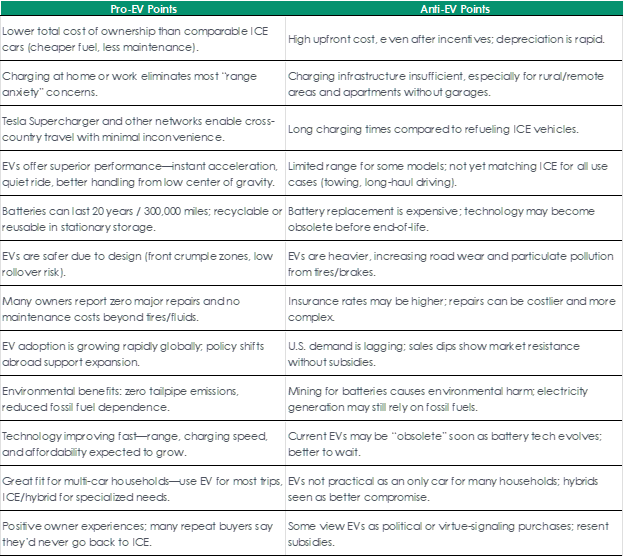 Then I thought, c’mon, man. Give me the funny stuff. Reader quotes are provided in Table 2.
Then I thought, c’mon, man. Give me the funny stuff. Reader quotes are provided in Table 2.
Table 2 EV Jousting with Spice
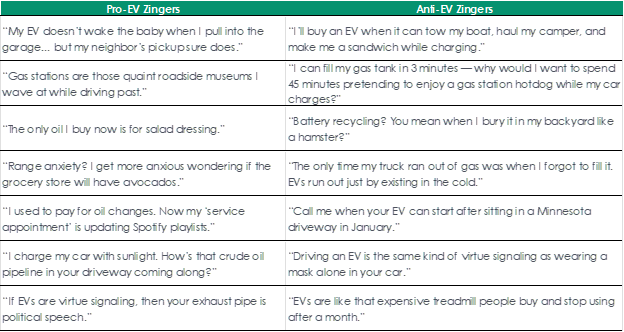 It boils down to use cases, personal preferences, and statements. For example, Heatmap lampooned Trump’s call to get rid of the EV and mileage “mandates,” which would increase gas prices, all else equal. Well, duh. The article references the EPA’s recent study, Reconsideration of 2009 Endangerment Finding and Greenhouse Gas Vehicle, which notes U.S. consumers favor larger vehicles (SUVs and pickups) and preferences are driven by perceived utility, safety, and status (making a statement about the driver). Fuel economy matters during short fuel-price spikes; otherwise, Americans don’t care.
It boils down to use cases, personal preferences, and statements. For example, Heatmap lampooned Trump’s call to get rid of the EV and mileage “mandates,” which would increase gas prices, all else equal. Well, duh. The article references the EPA’s recent study, Reconsideration of 2009 Endangerment Finding and Greenhouse Gas Vehicle, which notes U.S. consumers favor larger vehicles (SUVs and pickups) and preferences are driven by perceived utility, safety, and status (making a statement about the driver). Fuel economy matters during short fuel-price spikes; otherwise, Americans don’t care.
Regarding the use case, I thought I’d bet EV drivers drive much less. It depends on what “much less” means, but I had Sam pull used car data randomly and found the following average annual miles from vehicles for sale online (Table 2). Not only do certain classes of drivers prefer higher fuel economy, they drive less! This makes total sense.
Figure 2 Annual Mileage by Vehicle Class
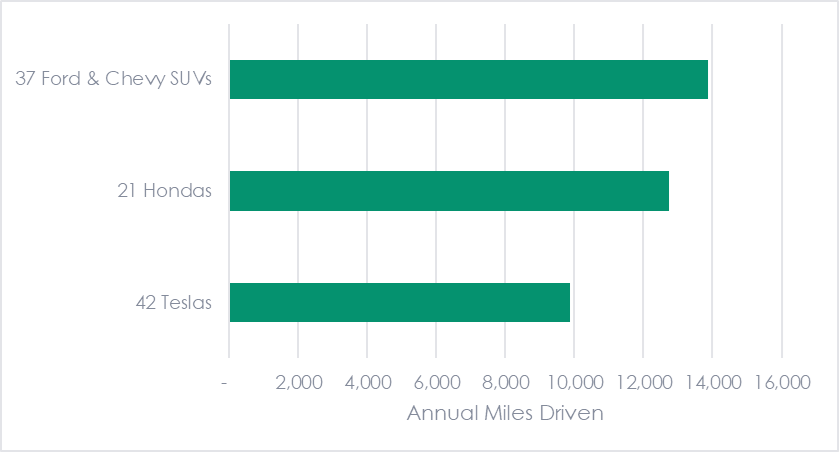 Conclusion: You might as well argue about ice cream flavors, pizza toppings, or whether doing the Kona Ironman is a preferred vacation versus sitting around and eating for a week on a cruise ship.
Conclusion: You might as well argue about ice cream flavors, pizza toppings, or whether doing the Kona Ironman is a preferred vacation versus sitting around and eating for a week on a cruise ship.
